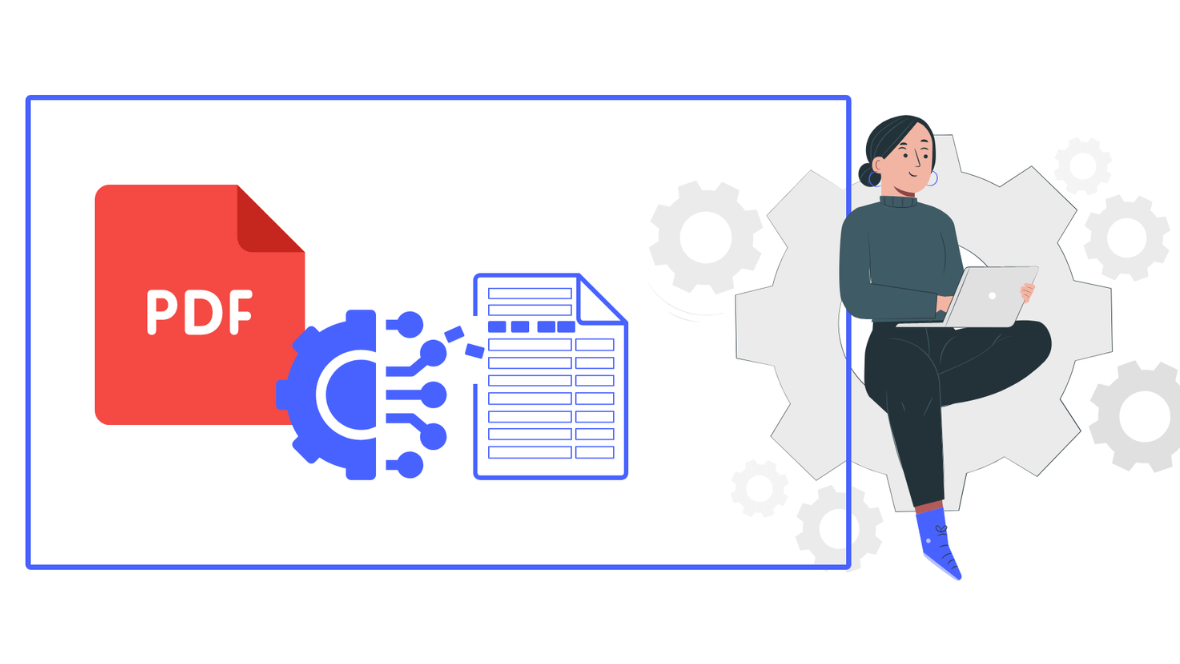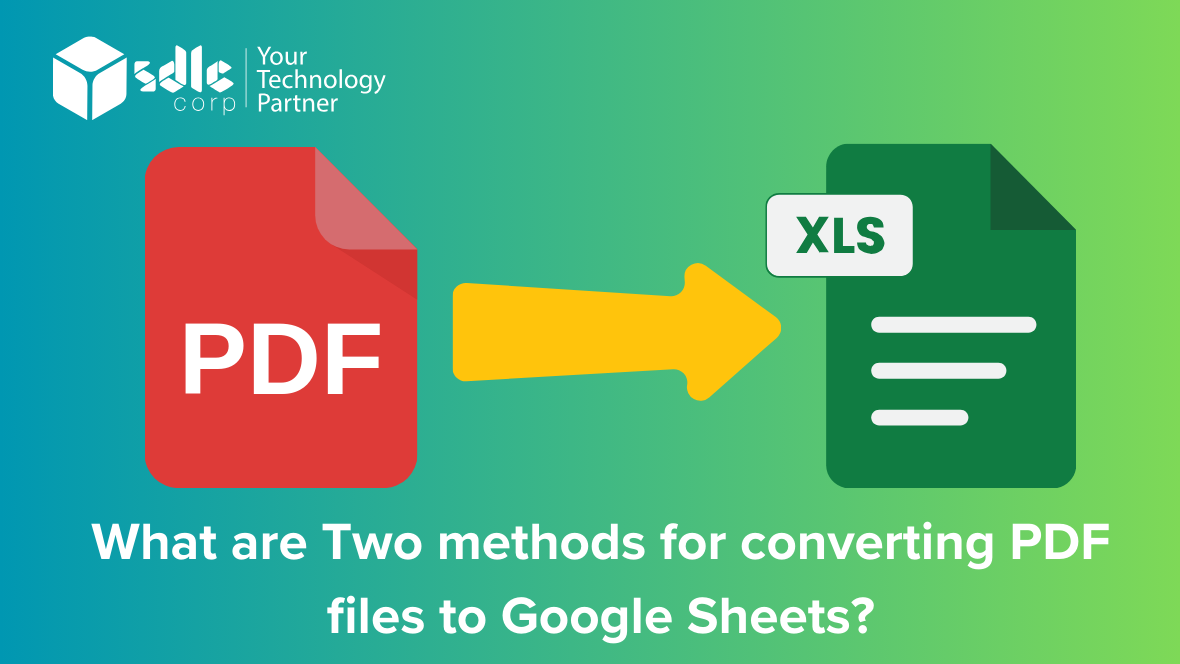What are Two methods for converting PDF files to Google Sheets?
Transferring PDF files to Google Sheets can be achieved through two main methods. The first method involves manual data entry, where users manually copy and paste data from the PDF file into Google Sheets. This process requires opening both the PDF file and Google Sheets simultaneously, selecting the desired content within the PDF, and transferring it into the corresponding cells in Google Sheets using copy and paste commands. This method offers control over data selection and entry but can be time-consuming and prone to errors, especially with large datasets.
The second method utilizes Google Sheets’ built-in functions, such as “IMPORT DATA” or “IMPORTED,” to directly import data from external sources, including PDF files. Users upload the PDF file to a cloud storage service like Google Drive and then use the appropriate function in Google Sheets to retrieve the data. This method is more automated and efficient, particularly for structured data or tables within the PDF. However, it may require additional configuration and adjustment of parameters, depending on the format and layout of the PDF file.
Considerations for both methods include data formatting and cleaning, as well as the potential use of automation tools for large-scale conversions. Despite their differences, both methods enable users to transfer data from PDF files into Google Sheets, facilitating easier analysis, collaboration, and visualization of information contained within the documents.
How Its Work?
Here’s an overview of two methods for transferring PDF data to Google Sheets, along with details on how to add a PDF image to text:
Method 1: Using Google Apps Script
Google Apps Script is a powerful tool that allows users to automate tasks and interact with Google Workspace applications like Sheets. Follow these steps to transfer PDF data to Google Sheets using Apps Script:
- Install the PDF to Sheets Script: Start by opening Google Sheets and navigating to “Extensions” > “Apps Script.” This opens the Google Apps Script editor. Delete any code in the script editor and paste the PDF to the Sheets script code. Save the script.
- Authorize the Script: Before running the script, you need to authorize it to access your Google Drive. Click on the “Run” button to execute the script. Follow the prompts to authorize the script.
- Select PDF File: After authorization, go back to your Google Sheet, and you should see a new menu item labeled “PDF to Sheets.” Click on it and select “Import PDF.” Choose the PDF file you want to import data from.
- Review and Import Data: The script will parse the PDF and display the extracted data in a dialog box. Review the data to ensure accuracy, then click “Import Data” to transfer it to your Google Sheet.
Method 2: Using External Tools
Alternatively, you can use external tools like Zapier or Integromat to automate the process of transferring PDF data to Google Sheets:
- Create a Zap or Scenario: In Zapier or Integromat, create a new automation workflow. Choose a trigger that initiates the process, such as receiving a new PDF file in your email or cloud storage.
- Set Up Actions: Once triggered, specify actions to be performed. For example, in Zapier, you can use the “Parseur” app to extract data from the PDF, and then add it to Google Sheets using the “Google Sheets” app. In Integromat, you can use modules like “PDF Parser” and “Google Sheets” to achieve similar results.
- Configure Data Mapping: In both Zapier and Integromat, you’ll need to map the extracted data fields to corresponding columns in your Google Sheet. This ensures that the data is accurately transferred and organized.
To add a PDF image to text, you can use Optical Character Recognition (OCR) tools. OCR software converts images containing text into editable text documents. Here’s how to incorporate this into your workflow:
Incorporate Extracted Text: Once you have the extracted text, you can add it to your Google Sheet using the methods described above. This text can now be analyzed, manipulated, or organized alongside other data in your sheet. By following these methods, you can efficiently transfer PDF data to Google Sheets and incorporate PDF images into text for further analysis and processing.

Challenges With Parsing a PDF Document
Parsing a PDF document can pose several challenges due to the inherent complexity and variability of PDF files. These challenges include:
1. Complexity of Format: PDF files can contain a wide range of elements such as text, images, tables, and hyperlinks, often arranged in complex layouts. Parsing these elements accurately requires sophisticated algorithms to interpret the structure correctly.
2. Encoding and Compression: PDF files may use various encoding and compression methods for text and images, which can complicate the extraction process. Different encoding schemes and compression algorithms need to be handled appropriately during parsing.
3. Text Extraction: Text extraction from PDFs can be challenging due to factors like embedded fonts, ligatures, and kerning. In some cases, text may be represented as images or vector graphics, requiring optical character recognition (OCR) techniques for extraction.
4. Layout Preservation: Maintaining the original layout and formatting of the document while parsing is crucial, especially for documents with complex structures or specialized formatting requirements. Ensuring accurate spatial representation of elements like tables and columns adds to the complexity.
5. Metadata and Annotations: PDF files can contain metadata, annotations, and interactive elements like forms and multimedia content. Parsing these additional elements requires specific handling to extract relevant information while preserving document integrity.
6. Security Features: PDF files may be encrypted or password-protected, requiring authentication and decryption before parsing. Handling security features adds layer of complexity to the parsing process.
7. Version Compatibility: PDF files can be created using different versions of the PDF standard, each with its specifications and features. Ensuring compatibility with various PDF versions is essential for reliable parsing across different documents.
8. Error Handling and Robustness: PDF files can be corrupted, incomplete, or malformed, leading to parsing errors or unexpected behavior. Implementing robust error-handling mechanisms is necessary to handle such situations gracefully and prevent application crashes or data loss.
Addressing these challenges requires a combination of advanced parsing techniques, error-handling strategies, and adherence to PDF standards and specifications.
"Simplified PDF to Google Sheets Transfer: Exploring Two Methods"
The Modern Approach to Parsing PDF Documents
1. Complexity of PDF Structure: PDF documents can have complex structures, including nested elements, layers, and non-linear content flow. This complexity poses a significant challenge for parsing algorithms, as they need to accurately interpret the document’s layout and hierarchy to extract meaningful information. This complexity increases the difficulty of building robust parsing algorithms that can handle various PDF structures effectively.
2. Text Extraction Accuracy: One of the primary goals of parsing PDF documents is to extract text accurately. However, PDF files often contain text that is encoded in non-standard or proprietary formats, such as embedded fonts or image-based text. Extracting text accurately from such elements can be challenging, leading to errors or inaccuracies in the parsed output. Ensuring high accuracy in text extraction is crucial for applications that rely on the parsed data for further analysis or processing.
3. Handling of Visual Elements: PDF documents frequently include visual elements such as images, graphs, tables, and annotations, alongside textual content. Parsing algorithms need to be capable of identifying and extracting these visual elements accurately, as they often contain valuable information that cannot be represented solely as text. Handling visual elements adds another layer of complexity to the parsing process and requires sophisticated techniques, such as optical character recognition (OCR) for extracting text from images.
4. Metadata Extraction and Interpretation: PDF documents can contain a wide range of metadata, including author information, creation dates, document properties, and embedded links. Extracting and interpreting this metadata accurately is essential for understanding the context and origin of the document. However, parsing metadata can be challenging due to variations in how it is encoded and embedded within PDF files. Additionally, interpreting metadata correctly requires parsing algorithms to handle different metadata formats and standards effectively.
5. Security and Privacy Concerns: Parsing PDF documents may raise security and privacy concerns, particularly when dealing with sensitive or confidential information. PDF files can contain embedded scripts, links, or hidden content that pose security risks if not handled properly. Additionally, extracting text or metadata from PDF files may inadvertently expose sensitive information, such as personally identifiable information (PII) or intellectual property. Ensuring the security and privacy of parsed data is crucial, requiring parsing algorithms to implement robust security measures, such as sanitizing extracted content and adhering to data protection regulations.
PDF Conversion Metrics
1. Conversion Rate: Conversion rate refers to the percentage of users who successfully convert a PDF document into another format, such as Word, Excel, or HTML. This metric helps gauge the effectiveness of the PDF conversion process. A high conversion rate indicates that the conversion tool is user-friendly and efficiently converts documents without errors or glitches. Conversely, a low conversion rate may signify issues such as compatibility issues, slow processing times, or poor user experience.
2. Conversion Time: Conversion time measures the duration it takes for a PDF document to be converted into another format. This metric is crucial for assessing the efficiency and speed of the conversion process. A shorter conversion time is generally preferred as it indicates faster processing and turnaround times for users. Factors that can influence conversion time include the size of the PDF file, the complexity of its content, and the performance of the conversion tool or software.
3. Conversion Accuracy: Conversion accuracy evaluates the fidelity and precision of the converted document compared to the original PDF. It assesses whether the layout, formatting, text, images, and other elements are accurately preserved during the conversion process. High conversion accuracy is essential for ensuring that the converted document retains its integrity and usability. Poor conversion accuracy can lead to distorted layouts, missing content, or formatting errors, resulting in a negative user experience and potential productivity issues.
4. File Size Optimization: File size optimization measures the extent to which the size of the converted document is optimized without compromising its quality. PDF conversion tools often offer features to reduce the file size of converted documents, which can be particularly beneficial for sharing and storage purposes. This metric helps assess the efficiency of the optimization algorithms employed by the conversion tool. A well-optimized file size ensures that converted documents are lightweight, making them easier to share, download, and store, while still maintaining acceptable quality standards.
5. User Satisfaction: User satisfaction encompasses the overall satisfaction level of users with the PDF conversion process and the quality of the converted documents. It considers factors such as ease of use, reliability, speed, accuracy, and the availability of desired output formats. User satisfaction can be measured through surveys, feedback mechanisms, or user ratings and reviews. Monitoring user satisfaction provides valuable insights into areas for improvement and helps ensure that the PDF conversion tool meets the needs and expectations of its users.

Methods of Converting PDFs to Google Sheets
1. Manual Data Entry:
– Description: This method involves manually typing the data from the PDF into Google Sheets.
– Procedure: Open the PDF file and Google Sheets side by side. Then, manually input each data point, cell by cell, into the corresponding cells in Google Sheets.
– Pros: Provides full control over the data entry process, allowing for careful verification and correction of any errors.
– Cons: Time-consuming and prone to human error, especially with large or complex datasets.
2. Copy and Paste:
– Description: This method involves copying the text from the PDF and pasting it directly into Google Sheets.
– Procedure: Select the text from the PDF, copy it, and then paste it into Google Sheets. Google Sheets will attempt to parse the text into cells automatically.
– Pros: A relatively quick and simple method for transferring textual data. Preserves formatting to some extent.
– Cons: Formatting may not always transfer accurately, and non-textual elements (such as images or tables) will not be included.
3. Google Drive OCR (Optical Character Recognition):
– Description: Google Drive offers OCR functionality that can convert scanned PDFs into editable text, which can then be imported into Google Sheets.
– Procedure: Upload the PDF to Google Drive, right-click on the file, and select “Open with” > “Google Docs.” Once the document is open in Google Docs, the text will be editable. Then, copy and paste the text into Google Sheets.
– Pros: Can convert scanned documents and images with text into editable text. Preserves some formatting.
– Cons: May not accurately recognize text in complex layouts or poor-quality scans. Formatting may need significant cleanup.
4. Third-Party PDF Conversion Tools:
– Description: Numerous third-party tools and software exist specifically for converting PDFs to various formats, including Google Sheets.
– Procedure: Choose a reputable PDF to Google Sheets converter tool, upload your PDF file, and follow the instructions to convert it into a compatible Google Sheets format. Then, import the converted file into Google Sheets.
– Pros: Can handle complex PDF layouts and large datasets more efficiently than manual methods. Some tools offer batch processing capabilities.
– Cons: Quality and accuracy may vary depending on the tool used. Free tools may have limitations on file size or a number of conversions.
5. Google Sheets Add-ons:
– Description: Google Sheets offers add-ons that extend its functionality, including some that facilitate PDF conversion.
– Procedure: Install a PDF conversion add-on from the Google Workspace Marketplace. Follow the add-on’s instructions to upload your PDF and convert it into a Google Sheets-compatible format.
– Pros: Integration with Google Sheets streamlines the conversion process. Some add-ons offer advanced features such as customizable data extraction.
– Cons: Availability and quality of add-ons may vary. Some add-ons may require a subscription or payment for full functionality.
These methods offer various approaches to converting PDFs into Google Sheets, catering to different preferences, needs, and levels of technical expertise. Choose the one that best suits your requirements and workflow.
Automating PDF to Google Sheets Conversion
1. Using Google Apps Script with Google Sheets API:
– Description: Google Apps Script provides a powerful way to automate tasks within various Google services, including Google Sheets. You can write a script to interact with the Google Sheets API to import data from a PDF into a Google Sheet.
– Process: Write a script that uses the Google Sheets API to create a new sheet and parse the content of the PDF using PDF parsing libraries like PDF.js or PDFBox. Then, populate the Google Sheet with the extracted data.
– Automation: Schedule the script to run at specific intervals using Google Apps Script’s time-driven triggers, ensuring that the conversion process is automated.
2. Using Third-Party PDF Conversion Services with Google Sheets Integration:
– Description: Several third-party services offer APIs for converting PDFs to structured data formats like CSV or Excel. You can integrate these services with Google Sheets to automatically import PDF data.
– Process: Utilize a service like Zapier or Integromat to create a workflow that triggers PDF conversion when a new PDF is uploaded to a specified location (e.g., Google Drive folder). Once the conversion is complete, the data is automatically imported into a designated Google Sheet.
– Automation: Set up the workflow to run continuously, ensuring that any new PDFs are automatically converted and imported into the Google Sheet without manual intervention.
3. Using Google Cloud Platform (GCP) Services:
– Description: Google Cloud Platform offers a range of services for data processing and automation. You can leverage services like Cloud Functions and Cloud Vision API to automate PDF to Google Sheets conversion.
– Process: Develop a Cloud Function that triggers when a new PDF is uploaded to Google Cloud Storage. The function can use the Cloud Vision API to extract text and data from the PDF and then write this data directly into a Google Sheet.
– Automation: Configure Cloud Storage to watch for new PDF uploads and trigger the Cloud Function automatically. This setup ensures that PDF to Google Sheets conversion happens seamlessly without manual intervention.
4. Using Python Scripts with Google Sheets API:
– Description: Python provides powerful libraries for PDF manipulation and Google Sheets interaction. You can write a Python script to extract data from PDFs and update Google Sheets accordingly.
– Process: Develop a Python script using libraries like PyPDF2 or pdfplumber to extract text and data from PDFs. Then, use the Google Sheets API to update a Google Sheet with the extracted information.
– Automation: Set up a cron job or task scheduler on your local machine or a server to run the Python script at regular intervals. This way, the PDF to Google Sheets conversion process is automated without manual intervention.
5. Using Google Sheets Add-ons:
– Description: Google Sheets supports various add-ons that extend its functionality. You can find add-ons specifically designed for importing data from PDFs into Google Sheets.
– Process: Install a PDF import add-on from the Google Workspace Marketplace, such as “PDF to Sheets” or “PDF.co.” These add-ons typically allow you to specify a PDF file to import and customize the import settings. Once configured, the add-on will automatically import PDF data into the Google Sheet.
– Automation: Depending on the add-on, you may be able to schedule automatic imports at specified intervals or trigger imports based on certain events. Check the documentation or settings of the chosen add-on to configure automation options.
"Two Approaches for Importing PDFs into Google Sheets: A Comparison"
PDF to Google Sheets With Sdlccorp
Converting PDF documents to Google Sheets with SDLCCORP integration streamlines data management processes, ensuring seamless transfer of information across platforms. This innovative solution revolutionizes traditional data entry methods, offering efficiency and accuracy in handling diverse datasets. By harnessing the power of SDLCCORP technology, users can effortlessly extract data from PDF files and import them directly into Google Sheets, eliminating the need for manual input and minimizing the risk of errors.
The integration between PDF and Google Sheets empowers users to effortlessly transform static PDF tables into dynamic, editable spreadsheets with just a few clicks. With the inclusion of the keyword “pdf table to excel” in the content, this integration further enhances its functionality, enabling users to specifically target and convert tabular data within PDF documents into Excel-compatible formats. This comprehensive approach caters to diverse user needs, whether it’s analyzing financial reports, compiling research data, or managing inventory lists.
Furthermore, the seamless synchronization between PDF and Google Sheets facilitates real-time collaboration and data sharing among team members. Users can work collaboratively on Google Sheets, making updates and revisions instantaneously accessible to all stakeholders. This fosters a collaborative environment conducive to productivity and informed decision-making.
In summary, the PDF to Google Sheets integration with SDLCCORP represents a significant advancement in data management technology. By simplifying the conversion process and enhancing interoperability between platforms, this solution empowers users to streamline workflows, improve efficiency, and unlock the full potential of their data assets.
Creating a Simple Pipeline
1. Define Objectives and Inputs: Begin by clearly outlining the objectives of your pipeline. What problem are you trying to solve or what task are you trying to automate? Once you have a clear understanding of your objectives, identify the inputs required for your pipeline. These inputs could include data, resources, or any other necessary components.
2. Data Collection and Preprocessing: This step involves gathering the required data for your pipeline and preprocessing it to ensure it’s in a suitable format for analysis or further processing. Data collection methods will vary depending on your objectives and may involve scraping websites, accessing databases, or gathering sensor data. Preprocessing tasks may include cleaning the data, handling missing values, and transforming it into a format suitable for analysis.
3. Model Development and Training: Once your data is preprocessed, you can begin developing and training your models. This step involves selecting appropriate algorithms or models based on your objectives and data characteristics. You’ll then train these models using the collected and preprocessed data. During training, you’ll adjust model parameters to optimize performance and ensure the model generalizes well to new, unseen data.
4. Validation and Evaluation: After training your models, it’s crucial to evaluate their performance to ensure they meet your objectives and requirements. This involves validating the models using separate validation datasets or cross-validation techniques to assess their generalization ability. You’ll also need to evaluate the models’ performance metrics, such as accuracy, precision, recall, or F1 score, depending on the nature of your task.
5. Deployment and Integration: Once you’re satisfied with the performance of your models, it’s time to deploy them into production environments. This step involves integrating the trained models into your existing systems or applications so they can make predictions or perform tasks in real time. You’ll need to consider factors such as scalability, reliability, and security when deploying your models to ensure they meet production requirements.
6. Monitoring and Maintenance: Even after deployment, your pipeline requires ongoing monitoring and maintenance to ensure its continued effectiveness. This involves monitoring the performance of deployed models, detecting any drift or degradation in performance, and updating models or retraining them as necessary. Additionally, you’ll need to address any issues or bugs that arise and continuously improve your pipeline based on feedback and new requirements.
Conclusion
The first method, utilizing Google Apps Script, provides a seamless and automated solution for transferring PDF data directly into Google Sheets. By leveraging the powerful scripting capabilities of Google Apps Script, users can create custom functions to parse PDF content efficiently. This method is ideal for users who prefer automation and require a streamlined workflow for handling PDF data within Google Sheets. However, it may require some programming knowledge and customization to suit specific use cases.
On the other hand, the second method, using third-party PDF to Excel converters, offers simplicity and convenience for users who prefer a more straightforward approach. These converters often feature user-friendly interfaces and require minimal setup, making them accessible to users with varying levels of technical expertise. By converting PDFs to Excel format first, users can then easily import the data into Google Sheets for further analysis or manipulation. While this method may involve an additional step compared to direct PDF parsing, it provides a reliable solution for converting PDF data into a compatible format for Google Sheets.
FAQs
1. What is the process for manually entering data from a PDF into Google Sheets?
To transfer PDF data manually, you’ll need to open the PDF file, extract the relevant information, and then input it into Google Sheets cell by cell or row by row. This process involves copying data from the PDF and pasting it into the corresponding cells in Google Sheets. It’s a time-consuming method but can be useful for smaller datasets or when automation isn’t feasible.
2. Why should I use Google Sheets' built-in PDF import feature instead of manual entry?
Google Sheets’ built-in PDF import feature allows you to directly import PDF files into a spreadsheet, automatically converting the text and tables into editable cells. This saves time and effort compared to manual entry, especially for larger datasets. Additionally, it helps maintain data accuracy and reduces the risk of errors introduced during manual transcription.
3. Are there options to customize how PDFs are imported into Google Sheets?
Yes, Google Sheets’ PDF import feature offers some customization options. You can choose whether to import the entire PDF or specific pages, adjust the formatting settings, and specify how to handle tables, images, and text formatting. These options allow you to tailor the import process to suit your needs and ensure the imported data is organized correctly in the spreadsheet.
4. Are there any limitations or challenges when transferring PDFs to Google Sheets?
While Google Sheets’ PDF import feature is generally effective, there are some limitations. Complex layouts, non-standard fonts, and scanned PDFs without selectable text may not transfer accurately, resulting in formatting issues or incomplete data extraction. Additionally, tables embedded within images or graphics may require manual adjustment after import.
5. Besides manual entry and Google Sheets' built-in feature, are there other ways to transfer PDFs to Google Sheets?
Yes, there are alternative methods and third-party tools available for transferring PDF data to Google Sheets. These include using Google Apps Script to automate the import process, utilizing OCR (optical character recognition) software to extract text from scanned PDFs, or employing data extraction tools designed specifically for converting PDFs to spreadsheets. Each method has its advantages and may be more suitable depending on the complexity and volume of the PDF data.
Contact Us
Let's Talk About Your Project
- Free Consultation
- 24/7 Experts Support
- On-Time Delivery
- sales@sdlccorp.com
- +1(510-630-6507)















